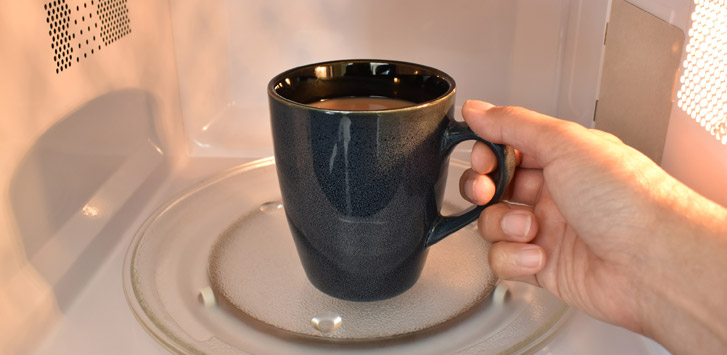As an Amazon Associate CoffeeXplore.com earns from qualifying purchases.
Can You Microwave Coffee? Tips for Safe, Flavorful Reheating
Ever wondered if you can microwave coffee when your fresh brew goes cold? It’s a common dilemma that coffee lovers face daily.
Cold coffee can ruin your morning ritual, and reheating it wrong can make your favorite brew taste bitter and unpalatable. Nobody wants to waste a perfectly good cup of coffee or spend time making a fresh batch.
Yes, you can microwave coffee, but it should be done carefully at 50% power in 30-second intervals to maintain optimal flavor and avoid overheating. While microwaving is convenient, it can alter the coffee’s chemical composition and potentially affect its taste.
As a certified coffee expert and consultant who has spent over a decade studying coffee chemistry and brewing methods, I’ve extensively researched and tested various coffee reheating techniques. In this comprehensive guide, I’ll reveal the science behind microwaving coffee, share expert tips for maintaining flavor, and explore alternative reheating methods that might work better for your needs. Whether you’re a casual coffee drinker or a dedicated enthusiast, you’ll discover exactly how to handle that cold cup of coffee without compromising its taste.
Key Facts:
– Coffee’s chemical composition changes when reheated, potentially affecting flavor and aroma
– Microwaving at 50% power helps preserve coffee quality better than full power
– The ideal reheating temperature for coffee is between 135-155°F (57-68°C)
– Ceramic or glass containers are best for microwaving coffee
– Coffee can typically be safely reheated within 4 hours of brewing
What Happens to Coffee When You Microwave It?
When you microwave coffee, the electromagnetic waves cause water molecules to vibrate, creating heat through friction, which can break down coffee’s aromatic compounds and alter its chemical structure. This process directly impacts both the flavor and overall drinking experience.
The Chemical Changes That Occur During Reheating
Coffee undergoes several significant chemical transformations when exposed to microwave radiation. According to research from Perfect Daily Grind, the reheating process can:
- Break down volatile compounds responsible for coffee’s signature aroma
- Accelerate oxidation of coffee oils
- Alter the pH level, increasing acidity
- Degrade chlorogenic acids that contribute to coffee’s antioxidant properties

Why Coffee Often Tastes More Bitter After Microwaving
The increased bitterness in microwaved coffee isn’t just your imagination. According to EatingWell, when coffee is reheated, it undergoes further breakdown of its chemical compounds, leading to:
- Enhanced bitter compounds release
- Loss of subtle flavor notes
- Degradation of natural sweetness
- Changes in mouthfeel and body
Key Takeaway: To minimize bitterness when microwaving coffee, use medium power settings and avoid overheating. The ideal temperature should feel hot but not scalding.
Temperature Distribution and Hot Spots
Microwave heating can create uneven temperature distribution, resulting in:
- Hot spots that can scald your mouth
- Cold patches that affect overall drinking experience
- Inconsistent flavor extraction across the cup
America’s Test Kitchen’s research shows that gentle warming to 140°F doesn’t significantly compromise coffee quality. However, exceeding this temperature can accelerate chemical degradation.
Can You Microwave Coffee Safely?
Yes, you can safely microwave coffee as long as you use appropriate containers, control the temperature, and follow proper reheating guidelines to minimize flavor degradation and ensure food safety.
The Best Containers for Microwaving Coffee
Choosing the right container is crucial for safely reheating coffee. Don Pablo Coffee experts recommend using:
- Ceramic mugs: Ideal for even heat distribution
- Glass containers: Safe and won’t affect taste
- Microwave-safe travel mugs: Convenient but check manufacturer guidelines
Avoid using:
– Metal containers
– Paper cups with metal rims
– Plastic containers that aren’t microwave-safe
– Disposable coffee cups
*
Step-by-Step Guide to Proper Reheating
Follow these expert-recommended steps for optimal results:
- Pour coffee into a microwave-safe container
- Set power level to 50%
- Heat in 30-second intervals
- Stir between intervals
- Check temperature (aim for 135-155°F)
Tip: Use a thermometer to ensure proper temperature without overheating. This helps preserve flavor while ensuring food safety.
Warning Signs Your Coffee Shouldn’t Be Reheated
Before microwaving your coffee, check for these warning signs that indicate it’s better to make a fresh brew:
- Off-putting smell or unusual odor
- Visible oil separation on the surface
- Left at room temperature for over 4 hours
- Already reheated multiple times
- Contains dairy products that have been sitting out
Food Fanatic notes that coffee with milk products should be handled with extra care due to food safety concerns.
What’s the Ideal Way to Reheat Coffee?
The ideal way to reheat coffee is using the stovetop method at low heat (around 200°F) with constant temperature monitoring, as this provides better control over heating and helps preserve the coffee’s original flavor profile.
Comparing Different Reheating Methods
Here’s a comprehensive comparison of popular coffee reheating methods:
| Method | Flavor Retention | Convenience | Time Required | Temperature Control |
|---|---|---|---|---|
| Microwave | Fair | Excellent | 1-2 minutes | Limited |
| Stovetop | Excellent | Good | 3-5 minutes | Excellent |
| Pour-Over | Very Good | Fair | 2-3 minutes | Good |
| Hot Water Bath | Good | Fair | 5-7 minutes | Very Good |
The Stovetop Method for Better Flavor
Tasting Table experts recommend the stovetop method for optimal results:
- Use a small saucepan or pot
- Heat on low-medium setting
- Stir occasionally to ensure even heating
- Monitor temperature with a thermometer
- Remove just before reaching desired temperature
Key Takeaway: The stovetop method takes longer but provides better temperature control and flavor preservation compared to microwaving.
Using a Pour-Over Setup for Reheating
For coffee enthusiasts who own pour-over equipment, try this innovative reheating method:
- Heat fresh water to 200°F
- Place cold coffee in your pour-over dripper
- Slowly pour hot water over the cold coffee
- Allow it to drip through naturally
This method can help:
– Maintain coffee oils integrity
– Preserve aromatic compounds
– Achieve optimal serving temperature
*
How Long Should You Microwave Coffee?
The optimal microwaving time for coffee is 30 seconds at 50% power, followed by 15-second intervals until reaching desired temperature (135-155°F). Total heating time should not exceed 2 minutes to prevent flavor degradation.
Optimal Time and Power Settings
Follow these guidelines for best results:
- Initial Heating:
- 30 seconds at 50% power
- Stir thoroughly
- Check temperature
- Additional Heating (if needed):
- 15-second intervals
- Stir between each interval
- Monitor temperature closely
According to Reddit coffee enthusiasts, using lower power settings helps preserve coffee quality.
The Interval Method for Even Heating
The interval method ensures more even heating and better temperature control:
- First Interval: 30 seconds at 50% power
- Stir thoroughly to distribute heat
- Check temperature with a thermometer
- Additional intervals of 15 seconds if needed
- Final temperature check before consuming
Tip: Never heat coffee for long periods at full power, as this can lead to overheating and bitter flavors.
Signs Your Coffee is Properly Reheated
Look for these indicators of properly reheated coffee:
- Steam rising from the surface
- Consistent temperature throughout
- No extremely hot spots
- Original aroma still present
- Smooth taste without excessive bitterness

Which Coffee Types Reheat Better Than Others?
Different coffee types respond differently to reheating, with black coffee generally maintaining its quality better than coffee with additives. Cold brew concentrate can be successfully reheated, while espresso-based drinks should ideally be consumed fresh.
Black Coffee vs Coffee With Milk
Understanding how different coffee preparations respond to reheating can help you make better decisions about your leftover coffee. Here’s a detailed comparison:
Black Coffee:
– Maintains flavor better when reheated
– Less chemical interaction during reheating
– Lower food safety risks
– More flexible reheating options
Coffee With Milk:
– Higher risk of bacterial growth
– More complex chemical interactions
– Limited reheating window (maximum 2 hours at room temperature)
– Requires extra caution when reheating
According to Quora coffee experts, milk-based coffees should be handled with extra care due to food safety concerns.
Cold Brew vs Hot Brew Reheating
Here’s how different brewing methods affect reheating success:
Cold Brew:
– More stable chemical composition
– Better flavor retention when heated
– Less acidity increase during reheating
– Can be diluted with hot water
Hot Brew:
– More volatile compounds
– Faster oxidation when reheated
– Higher risk of bitter notes developing
– Best consumed within 30 minutes of brewing
Key Takeaway: Cold brew concentrate can be successfully reheated by diluting with hot water, often producing better results than reheating regular hot-brewed coffee.
Specialty Coffee Considerations
For specialty coffee enthusiasts, consider these factors when reheating:
- Light Roasts:
- More delicate flavor compounds
- Higher risk of losing subtle notes
- Best consumed fresh
- Medium Roasts:
- Moderate stability when reheated
- Can maintain some flavor complexity
- Better results with gentle reheating
- Dark Roasts:
- More robust flavor profile
- Better tolerance to reheating
- Less noticeable flavor loss

What Are Common Mistakes When Reheating Coffee?
The most common mistakes when reheating coffee include using full microwave power, overheating beyond optimal temperature (135-155°F), using inappropriate containers, and attempting to reheat coffee that’s been sitting out too long.
Container Selection Errors
Avoid these common container mistakes when reheating coffee:
❌ Common Mistakes:
– Using non-microwave-safe containers
– Reheating in paper cups with metal rims
– Using plastic containers that can leach chemicals
– Choosing containers too small for the volume
✅ Best Practices:
– Use ceramic or glass mugs
– Ensure containers are microwave-safe
– Choose appropriate size for coffee volume
– Check for any damage or cracks
Perfect Daily Grind suggests that container selection significantly impacts both safety and flavor retention.
Temperature Control Issues
Common temperature-related mistakes include:
- Overheating:
- Causes excessive bitterness
- Destroys flavor compounds
- Creates scalding risk
- Uneven Heating:
- Creates hot and cold spots
- Results in inconsistent taste
- Affects overall experience
- Power Level Errors:
- Using full power instead of 50%
- Not using intervals
- Failing to stir between heating
Tip: Always use a thermometer or temperature-sensing mug to achieve optimal drinking temperature without overheating.
Storage Problems That Affect Reheating
Proper storage is crucial for successful reheating. Here are common storage mistakes to avoid:
❌ Storage Mistakes:
– Leaving coffee at room temperature too long
– Using airtight containers while coffee is hot
– Storing in direct sunlight
– Keeping coffee in the original paper cup
✅ Correct Storage Methods:
– Transfer to appropriate container immediately
– Refrigerate within 2 hours if planning to reheat
– Use clean, sealed containers
– Keep away from strong odors
If you’re interested in proper coffee storage techniques, check out our guide on how to take care of your coffee equipment.
FAQs About Microwaving Coffee
Q: Does microwaving coffee destroy caffeine content?
A: No, microwaving coffee does not significantly reduce its caffeine content. While some chemical compounds in coffee break down during reheating, caffeine remains stable at typical microwave reheating temperatures.
Q: Can you microwave coffee in paper cups?
A: No, you should not microwave coffee in paper cups. Paper cups often contain plastic linings or adhesives that can leach into your coffee when heated, and some may have metal rims that can cause sparking in the microwave. Always use microwave-safe ceramic or glass containers.
Q: Is it safe to reheat day-old coffee?
A: Day-old coffee can be safely reheated if it has been properly stored in the refrigerator within 2 hours of brewing. However, coffee left at room temperature for more than 4 hours should be discarded due to potential bacterial growth, especially if it contains milk products.
Q: Why does microwaved coffee taste different?
A: Microwaved coffee tastes different because reheating breaks down volatile aromatic compounds and accelerates oxidation, leading to increased bitterness and altered flavor profiles. This process can be minimized by using lower power settings and proper reheating techniques.
Q: How many times can you reheat coffee?
A: Coffee should ideally only be reheated once. Multiple reheating cycles significantly degrade flavor compounds and increase bitterness. For the best taste experience, it’s recommended to make fresh coffee rather than repeatedly reheating the same batch.
Summary
When it comes to microwaving coffee, the process is more nuanced than simply hitting the start button. While you can microwave coffee, success lies in the details of how you do it. The key is using 50% power in short intervals, maintaining optimal temperature between 135-155°F, and choosing the right container.
Throughout this guide, we’ve explored the science behind reheating coffee, from chemical changes that occur during microwaving to the best practices for preserving flavor. We’ve learned that while microwaving is convenient, alternative methods like stovetop reheating often produce better results in terms of taste preservation.
Remember these essential points:
– Use microwave-safe ceramic or glass containers
– Heat at 50% power in 30-second intervals
– Stir between intervals for even heating
– Consider alternative methods for specialty coffees
– Never reheat coffee multiple times
For more coffee brewing insights, check out our guides on how to clean your coffee equipment and comparing different brewing methods.
Final Tip: While reheating coffee is convenient, nothing beats the taste of freshly brewed coffee. If you find yourself frequently reheating coffee, consider investing in an insulated mug or making smaller batches to enjoy your coffee at its best.

